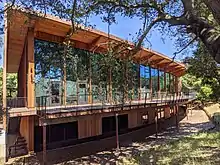| Established | 2016 |
|---|---|
| Students | 50-100 |
| Location | , USA |
| Affiliations | Stanford University |
| Website | knight-hennessy |
Knight-Hennessy Scholars is a graduate-level scholarship program for study at Stanford University. Established in 2016, the program seeks to prepare students to take leadership roles in finding creative solutions to complex global issues. Scholars receive full funding to pursue any graduate degree at Stanford and have additional opportunities for leadership training, mentorship, and experiential learning across multiple disciplines.
Program
The Knight-Hennessy Scholars program has a focus on attracting prospective graduate students with a wide range of backgrounds from around the world.[1][2][3] In addition to their graduate studies, scholars participate in leadership development programs, study trips, and have opportunities for mentorship with thought leaders in business, government, and nonprofit fields.[4]
Selection and Benefits
Potential applicants are required to apply to the Knight-Hennessy scholars program and, separately, to a Stanford University graduate degree program.[4] Of potential applicants, the scholarship program values leadership, independence of thought, and civic commitment.
Following the application deadline, 500 applicants are selected to complete video interviews. A group of finalists are asked to participate in in-person interviews. A final 50-75 scholars are then selected.
Since 2018, the program has offered annual financial support comprising full tuition and fees, room and board, related academic expenses, and a stipend for living expenses.[5]
Denning House

Denning House was built on the shore of Lake Lagunita on Stanford’s campus. The building serves as the center for the Knight-Hennessy scholars community.[4] Scholars gather at Denning House for presentations, workshops, and social events. The New York architectural firm Ennead designed the two-story building, which has classrooms, a dining area, meeting and lecture rooms, as well as office space for a fellow-in-residence and for the program's administrative staff.[6] The building was a gift from Steven A. Denning and his wife, Roberta Bowman Denning.[6]
See also
References
- ↑ Sara Germano, "Nike Founder Phil Knight Donates $400 Million to Stanford," Wall Street Journal, February 24, 2016.
- ↑ Merrit Kennedy, "Nike Co-Founder Donates $400 Million To Stanford University," NPR, February 24, 2016.
- ↑ "Stanford Stays the Course," Harvard Magazine, May–June 2016.
- 1 2 3 Michael Gioia, "Stanford launching Knight-Hennessy scholarship to attract top graduates," Stanford Daily, February 24, 2016.
- ↑ Alessandra Stanley, "Philip Knight of Nike to Give $400 Million to Stanford Scholars," New York Times, February 24, 2016.
- 1 2 Kathleen J. Sullivan, "Knight-Hennessy Scholars program wins approval for Denning House, holds first meeting of faculty advisory board," Stanford News, December 8, 2016.